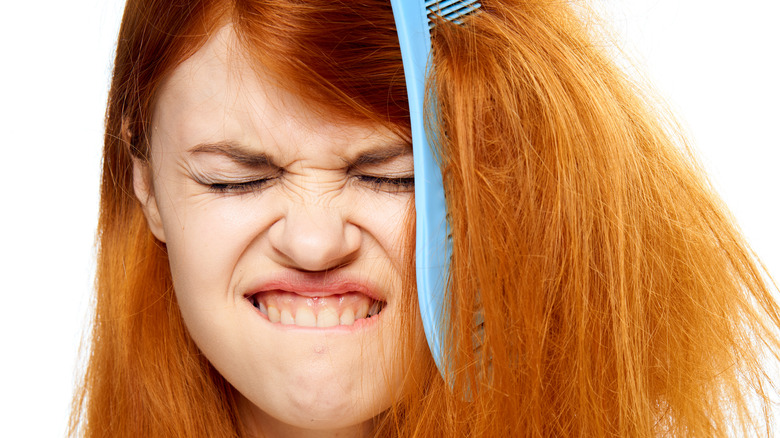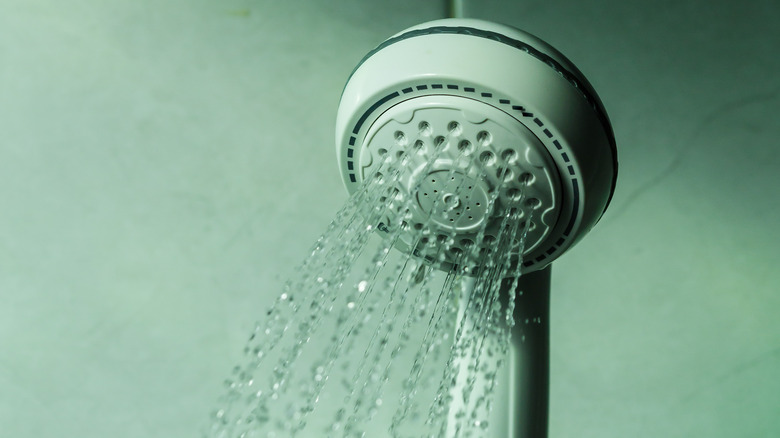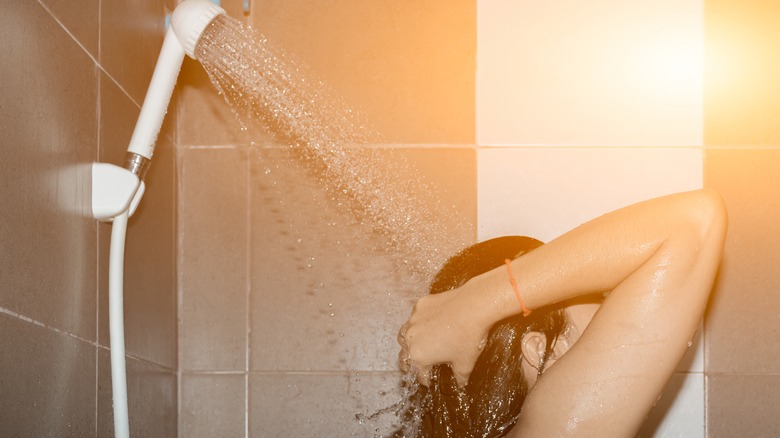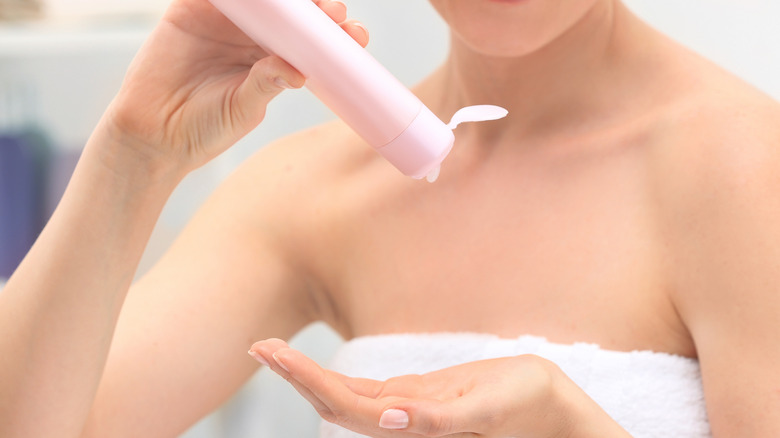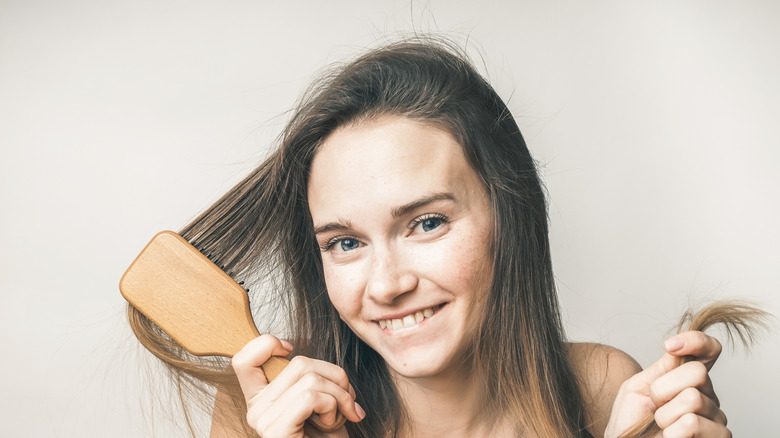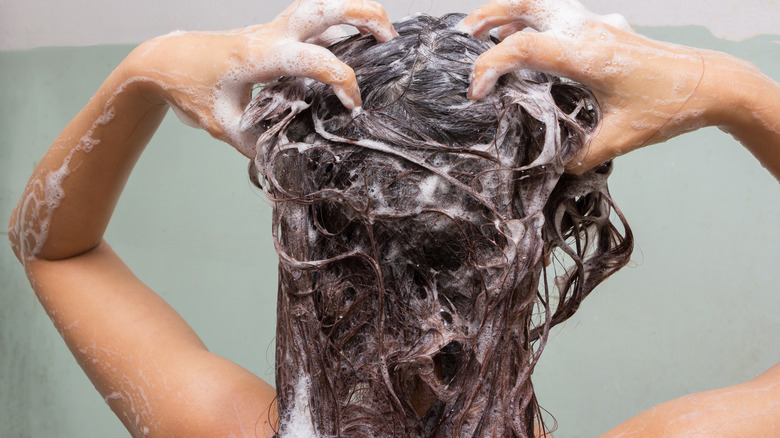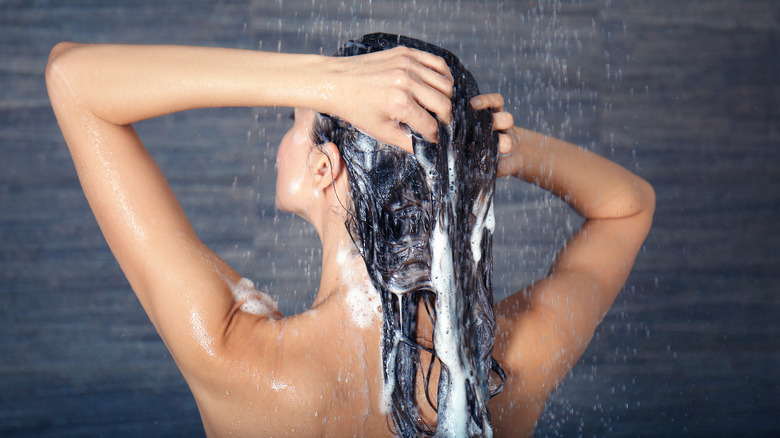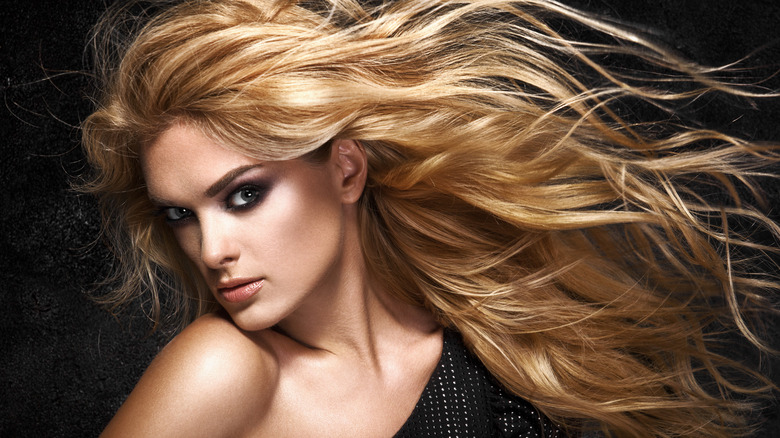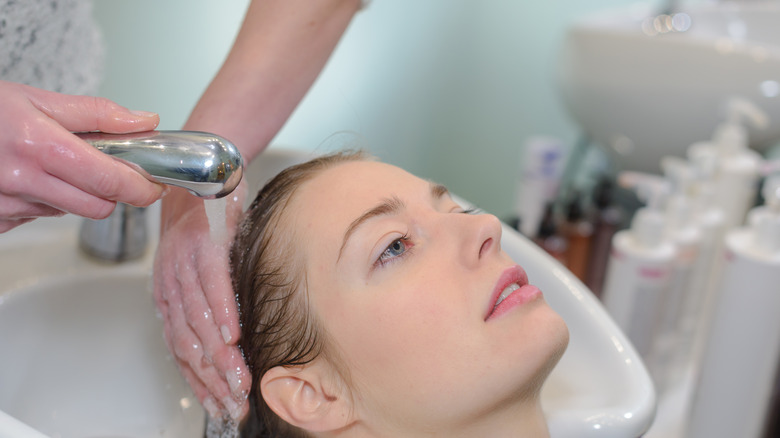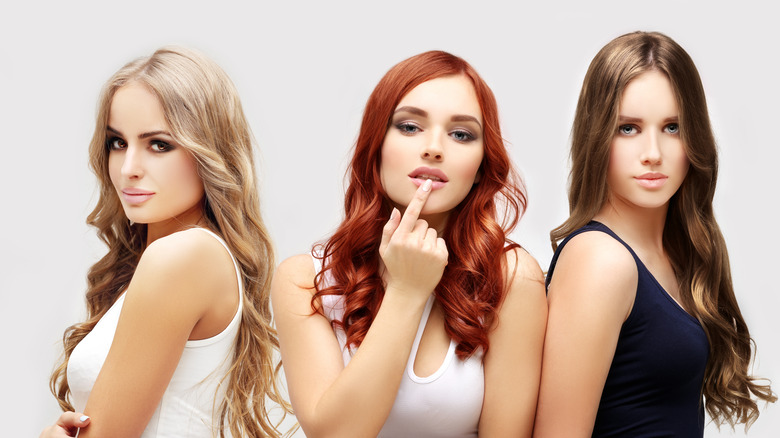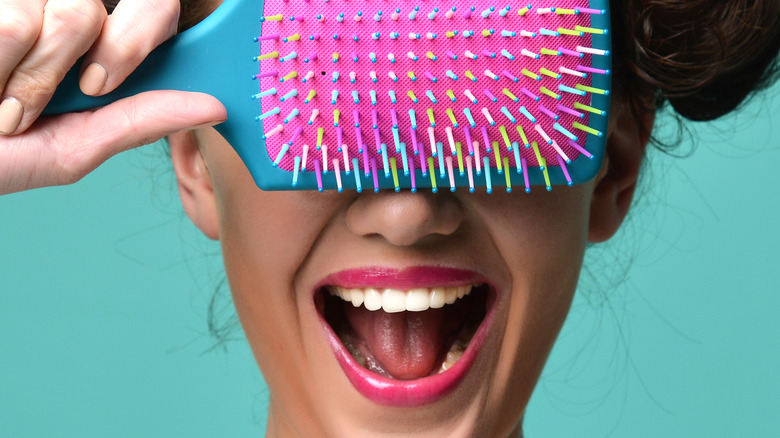When Washing Your Hair, This Is What You Should Avoid
Washing our hair is something most of us do several times a week and probably don't think much of, but it turns out you could be doing it the wrong way entirely. No one wants that because, as we all know, hair is super important in terms of how we look and feel. If you have been suffering from consecutive bad hair days, shampooing the wrong way could easily be the culprit — but don't fret.
I spoke to some of the top experts in hair care from all over the country to learn their best hair washing techniques, tips, and tricks. If you want your locks to shine, read carefully and use your head.
Combing your hair the wrong way before you wash
It is not easy to wash a head full of tangled hair, so most of us brush or comb it out before washing. But according to Fernando Salas, who is the founder and creator of the White Sands hair care line, combing your hair improperly can really damage your strands. Most of us have been taught to brush or comb our hair from top to bottom, but Salas says this is actually not the right way to go about it. He suggests adopting the "bottoms up" method, which is combing your hair in smaller pieces, starting at the bottom and working your way up toward your scalp.
He explained, "When you comb hair from the bottom up, you are working with less surface area to untangle at one time." To prevent breakage, Salas said, "Working in smaller sections like this is key. When you try to comb from the top down, think of how much hair you are attempting to pull a comb through at one time."
It is almost like untangling a knotted necklace. We all know it is much easier to get that final, tiny knot out than that giant first one. Salas' method ends up being more gentle on your hair.
Not thinking about where your water is coming from
For most of us, water comes out of our shower head and we don't give it another thought or wonder if the source of the water can affect our hair. But some kinds of water, especially hard water, can have a really big impact on how your hair looks after you've washed it.
However, if you are thinking about moving due to bad hair days, Shannon Combs, who is the owner and operator of Acorn Hill Salon and Spa in Lynchburg, Virginia says don't pack your boxes just yet. She explained, "You do not necessarily need to use filtered water, but depending on where you live, you might want to consider it, as mineral build up can change the color of your hair."
If hard water is your problem, you aren't alone. Michelle Guetersloh, a hairstylist and educator, revealed to me that over 80 percent of the country has hard water. Luckily, says Guetersloh, there are several easy solutions. "You should use hard water shampoo or crystal packets as needed to remove hard water build up that can make hair flat, hard, stiff, or brassy."
Using hot water
According to hair expert Sophia Porter, when it comes to washing your hair most women need to cool it down. She told me, "Women should try their best to avoid using hot water while washing because this strips the hair of its natural oils and fades color tremendously."
Stephanie Johnson of Fusion Studio in Dallas revealed that avoiding hot water is especially important for women with color treated hair. She explained, "The more hot the water, the more nutrients and color will be compromised. The cuticle is your protection, so protect it. Hot water on fine, damaged, or compromised follicles will be more damaging to [the cuticle] and hair. Rinse conditioners in cooler temperatures."
However, you don't need to use cold water all of the time. Guetersloh says washing in warm water is best for getting the gunk out of your hair. "Warm water should be used to shampoo and loosen and remove build up."Then, she suggests turning down the temperature after washing. "A cool rinse after can seal in moisture and add shine, as it makes the hair cuticle close down and appear smoother." But if the thought of using any cold water at all sends shivers down your spine, Combs suggests compromising and using lukewarm water instead.
Using certain chemical ingredients
Nearly every stylist I spoke with said to avoid all products with sulfates when washing your hair, but it isn't just hair stylists that don't like this ingredient — medical professionals also give it a no. Dr. Joel Schlessinger, a board certified dermatologist, says this ingredient doesn't just do a number on your hair, it can actually be harmful for people with sensitive skin and scalps. "[Avoid] sodium lauryl sulfate [because] sulfates can be irritating on skin and hair that is prone to eczema, allergies, or other irritations. Anyone with sensitive skin could benefit from switching to a gentle, sulfate-free shampoo."
Sulfates aren't the only ingredient you should avoid. Celebrity hairstylist Anthony Pazos added, "Never purchase shampoo or conditioner with parabens as they can coat the hair and leave a nasty layer of wax."
Johnson revealed the proof is in the price point and that it's important to the shell out a few extra dollars to get better products. "Budget shampoos are loaded with inexpensive cleansing agents including sulfates that dry and strip color. They contribute to frizz issues and more." She also suggested avoiding products that contain synthetic keratin. "Some of those brands with big budget advertising dollars can have synthetic keratin which can end up causing more harm from cuticle damage all the way to full-on scalp rejection."
Not considering your hair type
Different hair types require different methods and techniques when it comes to washing your hair. Guetersloh explained, "If hair is really oily, apply shampoo to hair before wetting it, to better remove build up."
Johnson said that paying attention to the condition of your scalp is also important and it comes up with her clients all of the time. "I just recently shared a tip with a lady who asked why her sensitive, dry, and flaky scalp wasn't clearing up. She was using clarifying shampoos that were adding to the problem and her scalp was out of balance. Professional products for your needs make a difference."
It's not just the condition of your hair and scalp, but also the length that should determine how you wash your hair, according to celebrity hair stylist Brandon Martinez. "A big mistake most women make, especially when it comes to having long hair, is that they are not using a leave in detangler after they wash."
Color can be another factor. Pazos says blondes especially need to pay attention to what shampoos they use and integrate a purple shampoo into their routine to cut the brass and "maintain that ashy blonde color."
Using the wrong shampooing technique
There is a very specific way you should do the actual shampooing when washing your hair. Johnson said, "Hair is most fragile when wet so you shouldn't be scrubbing all of your hair in a big pile on the top of your head. Shampoo is for the scalp and conditioner is for the mids to ends. [You need to] shampoo the scalp, run your fingers through to distribute the cleanser and then rinse."
Guetersloh also suggests you don't need to shampoo your entire head most of the time. "Most women shampoo from scalp to ends. This is drying to the ends. Shampoo is meant to strip oil and dirt away from the scalp, where it is being produced and trapped. So, only shampoo the scalp area, unless trying to remove an odor like bonfire smell."
According to celebrity hairstylist Deycke Heidorn, if you want your hair to look its best, you need to really take the time to do it. "Many women shower and quickly wash their hair at the same time. This way, hair care products can't be used to its full potential. Take the extra minute and your hair will look healthy and nourished. Massage shampoo with both hands. This will also stimulate your scalp for better blood circulation and hair growth."
Washing too often
Guetersloh told me that "98 percent of people do not need to shampoo every day. Some people say if they go more than a day, it gets too greasy. But, most of the time, we caused that problem." She explained washing your hair too often can cause multiple issues. "Over cleansing causes the scalp to amp up oil production to replace what is being stripped. When we stop shampooing so often, the body balances and you can go more days between shampoo. Less time for you and better for your hair. I tell most clients with this problem to start shampooing every other day and use dry shampoo on the day in between."
But she noted that results take time. "In two to three months, they should notice their hair is less oily. Only once has this not been the case and it is because there is an overproduction of oil genetically passed throughout their family. This is the exception, definitely not the rule."
According to Dr. Schlessinger, shampooing too often can have other repercussions as well. "If you have a sensitive scalp, shampooing too much can make this irritation worse because it strips the scalp of its natural oils and gives the scalp a dry, tight, and uncomfortable feeling. Generally, once daily is fine, but if you find shampooing every day is a little bit too much, try shampooing every other day instead."
Not paying attention to your extensions
Everyone knows that having extensions looks beautiful, but they require maintenance and rather specific guidelines for care. Kristina Gibson, a Beverly Hills hair stylist and extension expert, told me that people with any kind of extension, and especially tape-in extensions, have to be particularly careful when washing their hair. However, anyone with extensions knows that the areas of your scalp where they are installed can get extra dirty and even itchy.
Gibson suggests after gently cleansing your scalp, apply some extra shampoo to your fingertips. She instructed, "Carefully get in between each row of extensions with your fingers." When it comes to conditioner, Gibson advised to only apply it on your ends and avoid any kind of product that is oil-based.
Rinsing improperly
Rinsing might be the last step of washing your hair, but not the least important one. Doug Martucci, who is a stylist, salon owner, and the creative director at PRORITUALS, shared a huge mistake that many women make during this step. "A common hair myth is that you should rinse out all of the conditioner. Never do this," Martucci advised. "Rinsing all of the conditioner until your hair is squeaky clean is defeating the purpose of the conditioner. Conditioner provides slip and protection to the hair. If you're worried about being greasy rinse the scalp well, and leave that slippery feeling on the ends."
But when it comes to shampooing, the opposite is true. Heidorn explained that you should always rinse it off completely. "Do not rush while washing your hair. The cleansing ingredients in your shampoo are designed to spread the hair shaft. If shampoo remains in your hair after washing, your hair may look dull and your roots feel sticky and heavy. It makes it difficult to detangle if the hair shaft isn't smooth. Brushing your wet hair will cause breakage. Always make sure to rinse off shampoo well."
After rinsing, he suggests being as careful as possible because your hair will be in a delicate state when wet. "Wrap your hair in a large towel. Do not rub or forcefully massage your hair when it's wet! This will cause breakage."
Not considering your color
Color-treated hair needs to be treated differently than regular hair. It can also require different products and tools. Martinez explained. "Color-treated hair is extra sensitive to pulling which leads to breakage. Using a really good leave in conditioner and a Wet [detangling] brush, which every woman should have, will prevent breakage and unwanted tangling. After shampoo and conditioning, spray in the detangler, and brush through the hair, using the Wet brush."
Johnson says that women with colored hair in particular need to make sure they are buying the right products for washing their hair. She has noticed that many women who invest significant amounts of money on getting their color done will then go and spend as little as possible on the products they use. She believes this is really the wrong approach. "Don't spend hundreds on a color, hundreds on makeup, and then $5 on your shampoo."
Mistreating your wet hair
Once you've finished washing your hair, that wet hair is delicate and treating it harshly can cause breakage as well as a multitude of problems. Even if you don't have color-treated hair, Martinez is still a big proponent of the Wet brush and explained that women with long hair especially need to take extra care when their hair is wet. "Women [with long hair] must use a leave in conditioner and then a Wet brush, to prevent tangling. [If they don't, it can] lead to excess hair being pulled out."
He also added that there is another segment of the population that needs to use detangler. "This is also a great rule for teenage girls who are bad at brushing their hair out anyway. Their hair is changing from child hair to adult hair, and I always find this hair easily tangles."
Martinez also noted, "Another big no-no is putting your hair into a ponytail while it's wet. Wet hair is extra heavy, which causes unnecessary breakage and pulling."
